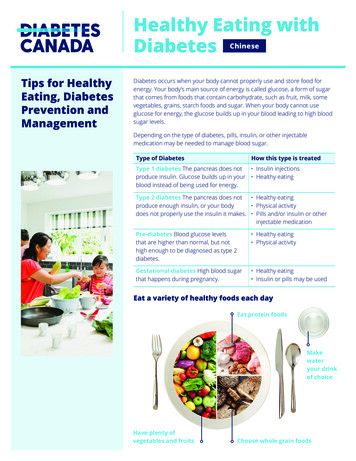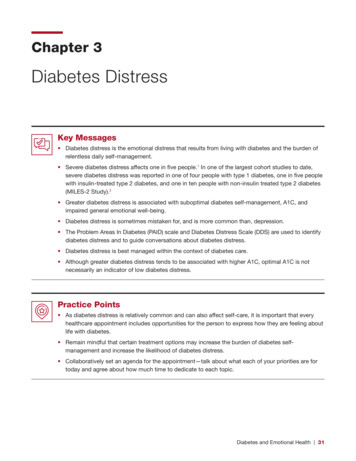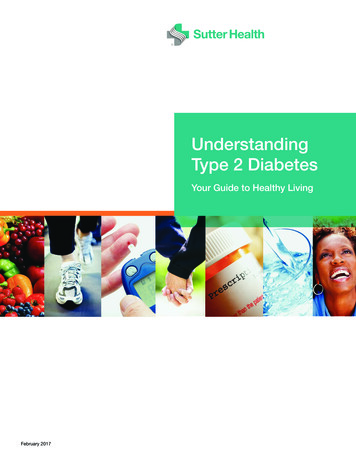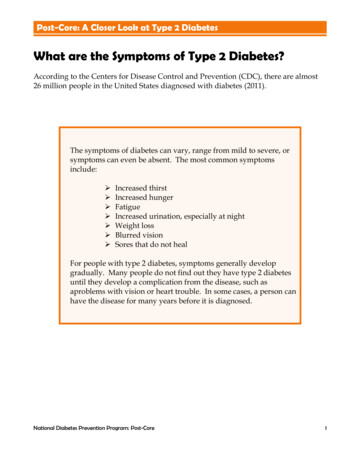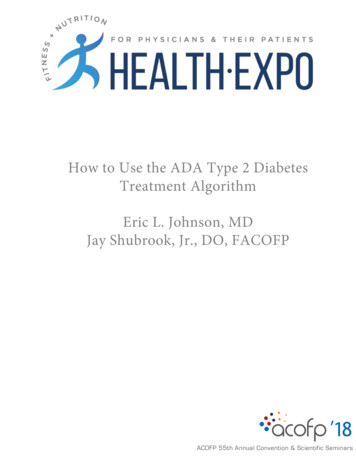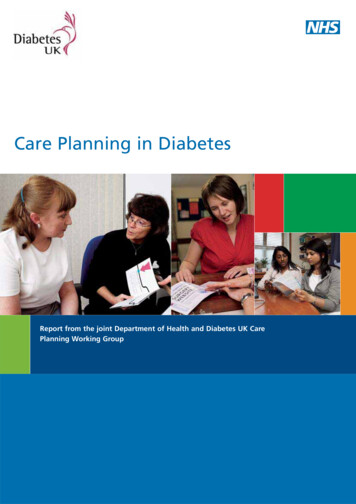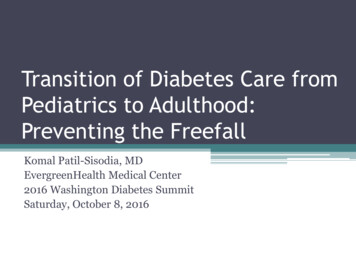
Transcription
Transition of Diabetes Care fromPediatrics to Adulthood:Preventing the FreefallKomal Patil-Sisodia, MDEvergreenHealth Medical Center2016 Washington Diabetes SummitSaturday, October 8, 2016
Presenter Disclosure InformationIn compliance with accrediting board policies, theAmerican Diabetes Association requires thefollowing disclosure to participants:Komal Patil-Sisodia, MD:Disclosed no conflict of interest
Objectives Understand the differences between pediatricand adult approach to DM care. Understand the issues emerging adults face asthey transition care to an adult provider. Review the available resources for pediatric andadult populations. Learn how to assemble a multidisciplinary DMcare team.
Image Credit: quotesgram.com
Introduction Transition from pediatric to adult care for DMmanagement is difficult. Studies worldwide have documented gaps incare that occur during this transition phase,which lead to poorer outcomes emerging adults. ADA 2011 Position Statement: Diabetes Care forEmerging Adults: Recommendations forTransition From Pediatric to Adult DiabetesCare Systems
Epidemiology SEARCH for Diabetes in Youth Study: 2001: 154,000 youth (age 20 years) with DM 2010: 215,000 youth (age 20 years) with DM Type 1 DM prevalence has doubled worldwide. Expected to double again in 15-20 years. Increased rates of childhood obesity areincreasing incidence of type 2 DM.
“Emerging Adulthood” Age range of 18-30 years. Young adulthood does not immediately followadolescence, but begins in late 20s/early 30s. 20-somethings delay assuming adult roles inmarriage, parenting, and work compared with youngadults in previous generations. Also need to take into account generationaldifferences in how patients and their parents engagewith healthcare providers. No studies or data exist on this topic in relation to DMcare.
Treatment Goals & Screening inPediatric DM Care Goal A1C 7.5% or 7% without excessivehypoglycemia. Pre-meal blood sugars 90-130 mg/dL. Bedtime/overnight blood sugars 90-150 mg/dL. Screening for associated autoimmune illnesses intype 1 DM (thyroid and celiac). Annual lipid screening. Exercise & weight management in type 2 DM. Screening for CV risk factors. Screening for retinopathy, neuropathy, andnephropathy in all patients.
Treatment Goals & Screening in AdultDM Care Goal A1C 7%; individualize based on age and risk of hypoglycemia.Pre-meal blood sugars 80-130 mg/dL.Peak postprandial blood sugars 180 mg/dL.Goal BP 140/90 (or 130/80 in select populations).Initial lipid screening at time of diagnosis, and annually thereafter ifindicated or every 5 years if panel at goal.Annual DM nephropathy screening with spot urine MA/Cr ratio andGFR to screen for microalbuminuria and CKD.Annual screening for DM retinopathy (if exam is negative for DR 2years in a row, then may consider every other year.Annual screening for DM neuropathy with 10-g monofilamenttesting plus either vibration sensation, pinprick, or temperaturetesting.Weight management with diet & exercise.
Pediatric Approach to DM care Assessment of individual vs. family barriers. Customize treatment plans to the needs of thefamily. Encouragement/teaching of self-care skills atappropriate stages of development. DM education refresh every few years. Working with schools/daycare providers toimprove their DM education and skills to helpcare for young children with diabetes.
Image: eight-gain
Teenagers are reportingstress levels that rivalthose of ss/2013/teen-stress.aspx
Issues Affecting Transitional Care Differences between the pediatric and adult care.Poor glycemic control.Loss to follow-up care.Acute complications.Psychosocial issues.Reproductive health issues.Substance use and abuse.Chronic complications.
Differences in DM ManagementPediatricAdult Family-centered approach. Parent-driven approach toaddress varying stages ofcognitive ability and emotionalmaturity. Emphasis on fitting DMmanagement techniques intofamily lifestyle. Individualized approach. Shorter visits focusing onmedical issues. Control of access to healthcareinformation in the hands ofthe patient. Autonomy to make ownmedical decisions.
Poor Glycemic Control SEARCH data: 32% of youth w/ T1DM ages 13-18 years achieveA1C target. 18% of youth w/ T1DM age 19 years achieve A1Ctarget. NHANES: 56% of adults are able to achieve target A1C. Teenagers with T1DM or T2DM have the highestproportion of A1C 9.5%. Estimated at 25%.
Cardiovascular Risk Factors Higher prevalence of CV risk factors in youthwith T2DM compared to T1DM. Increase in obesity rates now translating tosimilar increases in CV risk in T1DM patients. Obesity is increasing risk of hyperlipidemia,hypertension, and fatty liver disease.
Loss to Follow-Up Care Loss of private health insurance. Distractions interfere with successful DMmanagement – work, school, social. High risk of disengagement from health care inemerging adults leads to: Increased acute and chronic complications. Increased utilization of emergency services andhospital services. Higher relative risk of death in young adultswith diabetes.
Acute Complications Include: Hypoglycemia and hypoglycemia unawareness. Hyperglycemia. Diabetic ketoacidosis. Difficult to balance of school and/or work. Loss of parental supervision and less frequentmedical visits increase the risk of acutecomplications. DCCT data shoed higher rates of severehypoglycemia in adolescents age 13-17 years at studyentry and age 20-24 years at study end.
Psychosocial Challenges Occur more commonly in patients with DM. Diabetes-specific stressors: Lack of clear and concrete goals for diabetes care. Feeling discouraged/overwhelmed by diabetesregimen. Uncomfortable interactions withfamily/friends/coworkers about diabetes. Guilt/anxiety when off-track with diabetesmanagement. Worrying about future and possibility ofcomplications.
Mental Health Concerns Diabetes self-care is affected by: Anxiety Depression Eating disorders – anorexia, bulimia, disorderedeating behaviors Compounded by insulin omission and fear ofhypoglycemia.
Reproductive Healthcare Contraception and preconception counseling isespecially important to female patients with DM. Lower contraceptive use in adults with diabetes(ages 20-44) than in adults without diabetes 61% versus 73% Estimated that less than 25% of women withT1DM or T2DM are aware of maternal and fetalrisks of uncontrolled diabetes during pregnancy. Counseling on STD risk is also important.
Substance Use & Abuse Alcohol: Increases risk of severe hypoglycemia. Worsens glycemic control. Tobacco: Increases CV risk. Increases microalbuminuria risk. Need to discuss importance of abstaining fromsubstance use/abuse, especially while driving. Also need to address importance of BGmonitoring prior to driving.
Emergence of Chronic Complications Clinically apparent DM complication rates arelow, but there is evidence of early microvascularcomplications: Microalbuminuria 10% of adolescents w/ T1DM 30% of adolescents w/ T2DM Hypertension (T2DM T1DM) Retinopathy (T2DM T1DM) Neuropathy: 20% adolescents w/ DM
Emergence of Chronic Complications(cont.) Macrovascular complications: Early atherosclerotic disease seen inchildren/adolescents with elevated LDL, reducedHDL, tobacco use, and higher A1C levels. Complications are infrequently treated inpediatrics, but should be addressed prior totransition.
Which would you prefer?Photo credit (left): Free Fallin’ gallery on FlickrPhoto credit (right): www.skydivefortcollins.com
Planning the Transition of DM Care Recommended that transition occur over thecourse of a year at minimum. Planning checklists available to help withtransition. cklist/Pages/planningchecklist.aspx
Multifaceted Transition hResources
LEAP: Let’s Empower & Prepare Sequeira PA, et al.81 patients from 3 clinicsControl Group – usual careIntervention Group - structured transition program withtailored diabetes education, case management, groupeducation classes, and access to a newly developed youngadult diabetes clinic and transition website At 12 months, IG compared with CG participants had: Improved glycemic control (-0.40 1.16% vs. 0.42 1.51%[4.4 12.7 mmol/mol vs. 4.6 16.5 mmol/mol], P 0.01) Improved incidence of severe hypoglycemia (0.0% vs. 16%,P 0.02) Improved global well-being (P 0.02)
Transition Care Clinics Joslin Diabetes Center – Transition Program forYoung Adults C.S Mott Children’s Hospital – University ofMichigan Children’s Hospital of Wisconsin UCSF – Transition Program CHLA – LEAP Program Ohio State University – Adolescent TransitionProgram
ADA Recommendations1. Prepare adolescent and family for transition 1-2years in advance.2. Focus on DM self-management skills foradolescents & their parents to transferresponsibility.3. Address the differences between pediatric andadult providers in treatment approach to DM.4. Provide a comprehensive writtensummary/checklist to patient and future adultcare provider about patient’s history, medications,complications, and referrals.
ADA Recommendations (cont.)5. Recognize vulnerability of this population to loss ofconsistent healthcare and difficulty with adherence toself-care regimen.6. Refer to an adult provider well-versed in intensive DMmanagement for patients with T1DM and T2DM.7. Empower patients with resources to help insuresuccess – online resources, transition coordinator, etc.8. Prescribe individualized, developmentally appropriatecare that emphasizes adherence to DM selfmanagement/medications to prevent complications.9. Evaluate and treat for disordered eating behaviors andaffective disorders.
ADA Recommendations (cont.)10. Follow-up visits every 3 months for T1DM andevery 3-6 months for T2DM not on insulin.11. Screen patients for micro-and macrovascularcomplications.12. Start assessing for macrovascular risk in childhoodbased on current guidelines for lipid screening, BPassessment, and weight management.13. Contraception, risk of STDs, preconceptioncounseling, and substance use/abuse should bediscussed at length.14. Establish and coordinate primary and preventativehealthcare with a separate primary care provider.
Summary Pediatric to adult DM care transition is difficultand there is no standardized approach. Preparing the patient and their family well inadvance is important for success. Pediatric and adult DM providers need to workin tandem for this transition to be successful. Transitional diabetes care clinic development isnecessary. More research is needed to develop bestpractices for a successful transition.
References Peters A1, Laffel L; American Diabetes Association Transitions Working Group. Diabetes care foremerging adults: recommendations for transition from pediatric to adult diabetes care systems: aposition statement of the American Diabetes Association, with representation by the American College ofOsteopathic Family Physicians, the American Academy of Pediatrics, the American Association of ClinicalEndocrinologists, the American Osteopathic Association, the Centers for Disease Control and Prevention,Children with Diabetes, The Endocrine Society, the International Society for Pediatric and AdolescentDiabetes, Juvenile Diabetes Research Foundation International, the National Diabetes EducationProgram, and the Pediatric Endocrine Society (formerly Lawson Wilkins Pediatric Endocrine Society).Diabetes Care. 2011 Nov;34(11):2477-85.Sequeira PA, Pyatak EA, Weigensberg MJ, et al. Let's Empower and Prepare (LEAP): Evaluation of aStructured Transition Program for Young Adults With Type 1 Diabetes. Diabetes Care. 2015Aug;38(8):1412-9.Standards of Medical Care in Diabetes—2016: Summary of Revisions. Diabetes Care 2016 Jan;39(Supplement 1): S4-S5.ArnettJJ. Emerging adulthood. A theory of development from the late teens through the twenties. AmPsychol 2000;55:469–480.Weissberg-BenchellJ, WolpertH, AndersonBJ. Transitioning from pediatric to adult care: a newapproach to the post-adolescent young person with type 1 diabetes. Diabetes Care 2007;30:2441–2446.BrydenKS, PevelerRC, SteinA, et al. Clinical and psychological course of diabetes from adolescence toyoung adulthood: a longitudinal cohort study. Diabetes Care 2001;24:1536–1540.LaingSP, JonesME, SwerdlowAJ, et al. Psychosocial and socioeconomic risk factors for premature deathin young people with type 1 diabetes. Diabetes Care 2005;28:1618–1623.
Komal Patil-Sisodia, MDEvergreenHealth Diabetes & EndocrinologyPhone: (425) 899-6414Email: kpatil-sisodia@evergreenhealth.com
Osteopathic Family Physicians, the American Academy of Pediatrics, the American Association of Clinical Endocrinologists, the American Osteopathic Association, the Centers for Disease Control and Prevention, Children with Diabetes, The Endocrine Society, the International Society for Pediatric and Adolescent .

